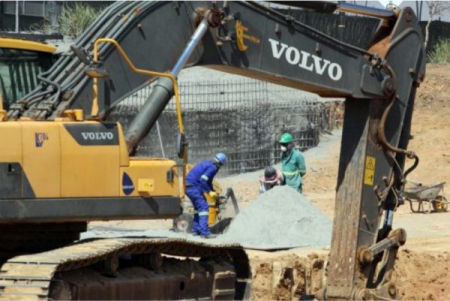Construction Sector Braces For A Stormy Year
Construction Sector Braces For A Stormy Year

South Africa’s distressed construction sector is facing a host of risks and challenges this year.
These include the continuing shortage of major projects, non-payment by government and other state entities, the risks to the economy from a sovereign credit ratings downgrade and the hijacking of construction sites by the so-called ‘construction mafia’ or business forums.
David Metelerkamp, senior economist at construction market intelligence firm Industry Insight, says 2019 was another tough year for the local construction industry, which has proven to be the worst performing sector in the South African economy over the last two to three years.
However, Metelerkamp adds that there was an improvement last year from the dismal performance in 2018, when sharp contractions were reported in construction activity.
He says the data released so far shows an estimated 2.7% decline in the nominal value of construction projects awarded in the 10 months to October last year compared to the 14.3% year-on-year decline reported in 2018.
However, Metelerkamp says the same cannot be said for the building industry, which has come under increased pressure as the economy continues to stagnate, business confidence remains at near record lows and South Africans are becoming increasingly poorer with rising unemployment.
Major risks
Metelerkamp highlights three major risks for the South African construction sector this year:
The 2020/2021 national budget,
Militant unrest, and Failing state-owned entities (SOEs) and a stagnant economy. He says the shocking state of the fiscus was revealed in the mini-budget speech last year and will have a negative effect on infrastructure allocations in the national budget due to be tabled in February.
“For the first time in several years, there was no mention of the total amount allocated for infrastructure in the mini-budget speech, which gives further anecdotal evidence that Treasury is still planning on how to deal with all of the funding shortfalls,” he says.
Metelerkamp adds that it is also widely accepted that Moody’s will downgrade South Africa’s sovereign credit rating to junk status this year or early next year.
“Although many economists and analysts believe that junk status is already priced into markets, the impact on the fiscus will be dire in the short to medium run, making it more expensive for government to borrow money to finance expenditure [on infrastructure, for example],” he says.
Metelerkamp adds that the hijacking of construction sites was a major theme last year, with these disruptions adding to the misfortunes of contractors.
“Unfortunately we are expecting the civil unrest and violence to continue, and there is a substantial chance of the situation actually getting worse.”
Metelerkamp says a stagnant economy is one of the biggest risks to the construction industry over the short to medium term, adding that one of the major bottlenecks to escaping this low-growth environment is serious economic and political reform, most importantly at SOEs, which remain in a state of disarray.
He says the construction industry will continue to face some serious headwinds in 2020 and beyond, with Industry Insight expecting the overall environment to remain constrained and unaccommodating to any sort of growth.
Webster Mfebe, CEO of the SA Forum of Civil Engineering Contractors (Safcec), says the major risks facing the sector this year include the availability of work for the industry, the possibility of a sovereign downgrade to SA’s credit rating, non-payment by state departments and allied entities, and disruption of activity at construction sites, although the frequency of these incidents has abated.
Despite these major risks, Mfebe anticipates that the construction sector will have a better this year than last year because the reality has dawned on the leaders of the country that South Africa is facing the possibility of a credit rating downgrade and therefore “all hands must be on deck to change that situation around”.
Government committed to ‘removing the inhibitors’
Mfebe says the renewed energy, collectivism and partnership started by the Public-Private Growth Initiative (PPGI), which is supported by President Cyril Ramaphosa, gives him hope this year will be better than last year because government is committed to removing the inhibitors to the economic projects that will boost economic growth and job creation.
“As the leader of construction within the PPGI I am very positive about the steps the government is taking but then contrast that with the lived experience of Safcec members whose order books are still at the lowest [level] or might be ticking up in a subdued manner,” he says.
Roy Mnisi, executive director of Master Builders South Africa (MBSA), says the lack of work remains one of the biggest challenges for the industry, together with non-payment by the state.
He says Eskom is also one of the major risks because it is an enabler to economic growth. “If Eskom is not functioning, the economy is not functioning and our sector is not functioning as well.”
Builders on a tightrope
Mnisi says that construction companies are continuing to experience financial difficulties and some of MBSA’s members have told him that if the situation does not improve, they will be applying to go into business rescue or liquidation.
The only thing that will save these companies, he says, is a change in economic growth and a change in government spending patterns.
On the outlook for the industry this year, Mnisi says reports received MBSA their members are indicative of “a continuous decline” and a lack of hope of any improvement in the economy.

























